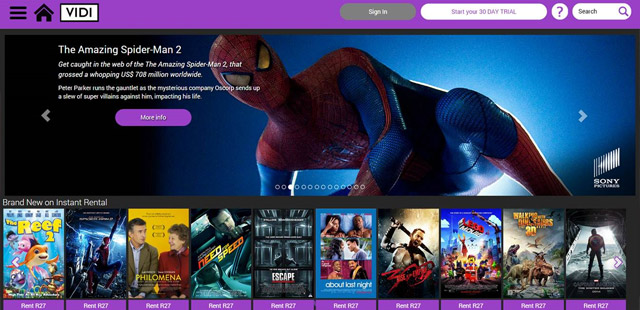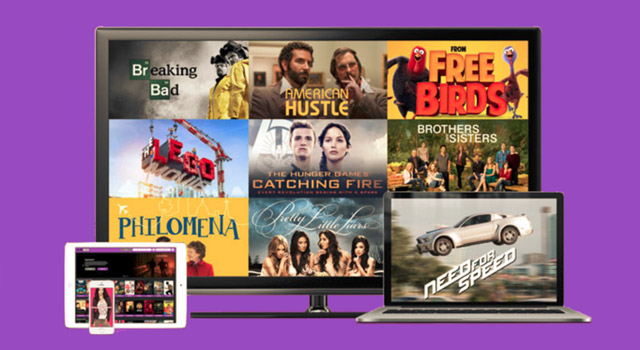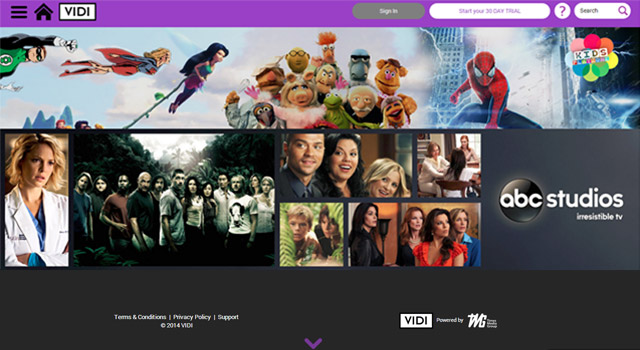
Times Media Group on Wednesday took the wraps off a “cord cutting” video-on-demand (VOD) service called Vidi. Vidi offers both subscription streaming and movie rental services via the Internet.
The JSE-listed media group is attempting to create something akin to Netflix, the US subscription streaming service that has set the benchmark for commercial online video streaming platforms, for South African audiences.
TechCentral broke the news about Times Media’s plans last month and had exclusive first access to the platform.
Vidi comes in two flavours. There’s an unlimited streaming service that costs R149/month and a rental service that costs between R15 and R27 per title, depending on the movie rented. Each rental is available to stream for 48 hours. The unlimited streaming service has a selection of older movies, with a variety of new and not-so-new television series on offer, too.
At launch, there will be 21 series available to stream (a total of 69 seasons, 1 325 episodes and more than a thousand hours of playtime).
Vidi will also have 100 movies on the subscription service at any given time and 72 titles in its rental offering.
The launch of Vidi signals a change in Times Media Group’s focus as the JSE-listed media firm, which owns venerable newspaper titles such as the Sunday Times and Business Day, shifts to a digital media platform covering television, radio and now VOD.
Times Media MD of broadcast and content Andrew Gill tells TechCentral that the group has undergone “quite a fundamental change in the past 18 months”.
“We created the broadcast and content division at the beginning of the year. In that time, we’ve been doing some significant restructuring of the business, selling off some of the legacy and non-core assets and investing in areas that have high growth potential.”

One of the assets it sold was cinema chain Nu Metro.
It has also invested in television and radio platforms elsewhere in Africa, including Ghana and Kenya, with plans to extend that reach.
“We have shifted from a traditional paper-based business, and we are now 13 radio stations and quite a few TV channels richer,” Gill says.
“We kept the film distribution business when we sold Nu Metro and many of the people who worked there have moved into the Vidi environment.”
The team has relationships with the big content studios, which has proved useful in sourcing material for the platform.
Times Media’s research shows there is sufficient demand in South Africa for a VOD service. Although early to market, and launching in a country plagued by Internet speed restrictions, Gill says it’s important to establish a beachhead. “The long-term growth opportunity is huge.”
Vidi hands-on
TechCentral had the opportunity to play with Vidi last week, ahead of the commercial launch. The interface is reminiscent of popular international services such as Netflix and Hulu, with a grid style layout of shows and movies that are available for streaming. Navigation is straightforward.
Subscribers are able to see upcoming titles under a “coming soon” section. And there are short descriptors for content, as well as trailers. Vidi does not offer users a set-top box. Instead, content is streamed via any of the latest Web browsers. Vidi will also offer Android and iOS applications.
Those wanting to watch Vidi on their big-screen TV will need an Internet connected device such as a PC connected to the screen.
The company is also developing an application for smart TVs, which should be ready by December. This will allow Internet-connected TVs to stream content directly.
Vidi will offer parental guidance. With an age restriction set, content that is not suitable for children will require a password to unlock it.
Each Vidi account will be able to connect up to four devices, while two concurrent streams are supported — great for parents who want to leave their children to stream cartoons while they watch a movie in another room.
Times Media is promising the latest content on the Vidi platform.
Marketing manager for VOD platforms, broadcast and content Taryn Uhlmann says titles on instant rentals will have just come off the cinema circuit, but not yet available on DVD or Blu-ray.

Uhlmann says that those titles will only become available on the subscription service when the licence makes it possible for Vidi to do so. It’s the same license process that Netflix, Hulu, and the BBC’s services adhere to, she says. “The timings will vary, but on average the movies that become available on subscription are two years after release.”
The subscription service comes with a 30-day free trial that requires viewers to provide their credit card details. They’ll have to remember to cancel before the 30 days are up if they don’t wish to subscribe.
Vidi will add an average of 200 hours of TV series each month, or approximately five new titles a month. On the subscription service, 10 movies will be added each month.
Vidi will offer titles from some of the largest Hollywood studios, including Sony, Warner and Disney, as well as independent studios Lionsgate and Relativity. Children’s programming will be provided by the titles on DHX Media’s Kids Playzone. Times Media is in discussions with more studios.
Pushing a strong library of local content is also a big focus. “There are three ways to expand our content offering, one is local content, which we are certainly working hard at. We have some local titles already, but we can strengthen that. Secondly, it’s widening the studio base, and lastly it’s about putting in niches and genres that aren’t widely available,” says Gill.
The technology
Times Media is expecting some user experience issues because the service is not the same as traditional broadcast television.
“We are using Microsoft Silverlight as the player technology and some older systems don’t support it,” says Gill. “Some users will also need to install Silverlight if they have not done so before.”
Silverlight is an application framework for Internet based media content not dissimilar to Adobe Flash.

Viewers will also have to ensure they have the latest version of their favourite Web browser installed.
Another major requirement for Vidi is a decent broadband connection. Although Gill says he has managed to watch streams on a 2Mbit/s connection without any buffering problems, he recommends a 4Mbit/s connection for good quality streaming in high definition. However, should a connection not be able to handle the stream, Vidi’s image quality will scale down automatically to prevent buffering.
The average amount of data that will be consumed per movie will depend on the speed of the user’s connection. On average, though, it will be about 2GB/movie.
Times Media has invested in a content distribution network for Vidi, with nodes in Johannesburg, Pretoria and Cape Town. It will expand this as needed based on the amount and location of data traffic.
“Our capacity for storing and streaming content is completely scalable,” says Gill. — © 2014 NewsCentral Media

